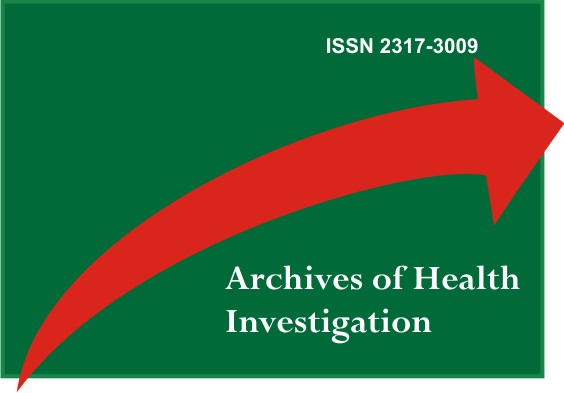VPH y Respuesta Sistémica en la Neoplasia Intraepitelial Cervical
DOI:
https://doi.org/10.21270/archi.v12i10.6235Palabras clave:
: Recuento de Células Sanguíneas, Neoplasia Intraepitelial Cervical, Papillomaviridae, Recuento de PlaquetasResumen
Objetivos: verificar si existe asociación del VPH de bajo y alto riesgo con los parámetros hemogramas en pacientes con neoplasia intraepitelial cervical. Métodos: Se evaluaron prospectivamente 48 pacientes con prueba de Papanicolaou que mostraron lesión intraepitelial de bajo o alto grado, sometidas a recolección de material para realizar PCR para VPH de alto y bajo riesgo. Se evaluaron los siguientes parámetros del hemograma: hemoglobina, glóbulos rojos, hematocrito, número absoluto de leucocitos, neutrófilos, linfocitos, eosinófilos, basófilos, monocitos y plaquetas, índice neutrófilo-linfocito (NLR), índice plaqueta-linfocito (PLR) y rojo. Ancho de distribución de celdas (RDW). Se utilizó la curva Receiver Operating Characteristic (ROC) para obtener el área bajo la curva (AUC) que relaciona la positividad o no del VPH con los parámetros del hemograma evaluados. Se realizó prueba de Mann-Whitney y análisis multivariado, con nivel de significación menor a 0,05. Resultados: Al relacionar la positividad o no del VPH con los parámetros del hemograma (curvas Roc), hubo significación estadística sólo entre el VPH de alto riesgo y el recuento de plaquetas (sensibilidad=75%, especificidad=66,7%, AUC=0,674, p= 0,039). Un recuento de plaquetas ≤ 177 000/mm3 se asocia con VPH de alto riesgo. Posteriormente se realizó el análisis multivariado y se consideró el valor absoluto de plaquetas como variable independiente en esta asociación con el VPH oncogénico de alto riesgo. Conclusión: Se encuentra respuesta sistémica con la presencia de VPH de alto riesgo en NIC. Por tanto, un recuento de plaquetas ≤ 177 000/mm3 se asocia con VPH de alto riesgo.
Descargas
Citas
Martins LFL, Thuler LCS, Valente JG. Cobertura do exame de Papanicolaou no Brasil e seus fatores determinantes: uma revisão sistemática da literatura. Rev Bras Ginecol Obstet 2005; 27(8):485-92.
zur Hausen H. Papillomavirus and cancer: From basic studies to clinical application. Nat Rev Cancer 2002;2(5):342-50.
INCA, 2020. Incidência do Câncer no Brasil. https://www.inca.gov.br/controle-do-cancer-do-colo-do-utero/conceito-e-magnitude. Accessed may 2022.
Bosch FX, Manos MM, Muñoz N, Sherman M, Jansen AM, Peto J, et al. Prevalence of human papillomavirus in cervical cancer: a worldwide perspective. International biological study on cervical cancer (IBSCC) Study Group. J Natl Cancer Inst 1995;87(11):796-802.
Bosch FX, Lorincz A, Muñoz N, Meijer CJLM, Shah KV. The causal relation between human papillomavirus and cervical cancer. J Clin Pathol 2002;55(4):244-65.
Chichareon S, Herrero R, Muñoz N, Bosch FX, Jacobs MV, Deacon J, et al. Risk Factors for Cervical Cancer in Thailand: a Case-Control Study, J Natl Cancer Inst 1998;90(1):50-7.
Nayar R, Wilbur DC, editors. The Bethesda system for reporting cervical cytology: definitions, criteria and explanatory notes. Third edition. New York: Springer International Publishing Switzerland; 2015
Tavares-Murta BM, Mendonça MAO, Duarte NL, Silva JA, Mutão TS, Garcia CB, Murta EFC. Systemic leukocyte alterations are associated with invasive uterine cervical cancer. Int J Gynecol Cancer 2010;20(7):1154-159.
Chun S, Shin K, Kim KH, Kim HY, Eo W, Lee JY, et al. The Neutrophil-Lymphocyte Ratio Predicts Recurrence of Cervical Intraepithelial Neoplasia. J Cancer. 2017;15;8(12):2205-211.
Farzaneh F, Faghih N, Hosseini MS, Arab M, Ashrafganjoei T, et al. Evaluation of Neutrophil-Lymphocyte Ratio as a Prognostic Factor in Cervical Intraepithelial Neoplasia Recurrence. Asian Pac J Cancer Prev. 2019;20(8):2365-372.
Lima PSV, Mantoani PTS, Murta EFC, Nomelini RS. Laboratory parameters as predictors of prognosis in uterine cervical neoplasia. Eur J Obstet Gynecol Reprod Biol. 2021;256:391-96.
Han X, Liu S, Yang G, Hosseinifard H, Imani S, Yang L, Maghsoudloo M, et al. Prognostic value of systemic hemato-immunological indices in uterine cervical cancer: A systemic review, meta-analysis, and meta-regression of observational studies. Gynecol Oncol. 2021;160(1):351-60.
Tas M, Yavuz A, Ak M, Ozcelik B. Neutrophil-to-Lymphocyte Ratio and Platelet-to-Lymphocyte Ratio in Discriminating Precancerous Pathologies from Cervical Cancer. J Oncol. 2019; 29;2019:2476082.
Chauhan R, Trivedi V, Rani R, Singh U, Singh K. Pre-treatment hematological parameters as a cost effective predictive marker for response to concurrent chemo radiation in locally advanced cervical cancer. Cancer Treat Res Commun. 2022; 22;31:100539.
Sharma D, Singh G. Thrombocytosis in gynecological cancers. J Cancer Res Ther. 2017; 13(2):193-97.
Wang JM, Wang Y, Huang YQ, Wang H, Zhu J, Shi JP, et al. Prognostic Values of Platelet-Associated Indicators in Resectable Cervical Cancer. Dose Response 2019;17(3):1559325819874199.
Wang H, Chen WM, Zhou YH, Shi JP, Huang YQ, Wang WJ. Combined PLT and NE to predict the prognosis of patients with locally advanced cervical cancer. Sci Rep. 2020;10(1):11210.
Cheng J, Zeng Z, Ye Q, Zhang Y, Yan R, Liang C, et al. The association of pretreatment thrombocytosis with prognosis and clinicopathological significance in cervical cancer: a systematic review and meta-analysis. Oncotarget. 2017;8(15):24327-336.
Zheng RR, Huang XX, Jin C, Zhuang XX, Ye LC, Zheng FY, et al. Preoperative platelet count improves the prognostic prediction of the FIGO staging system for operable cervical cancer patients. Clin Chim Acta. 2017;473:198-203.


